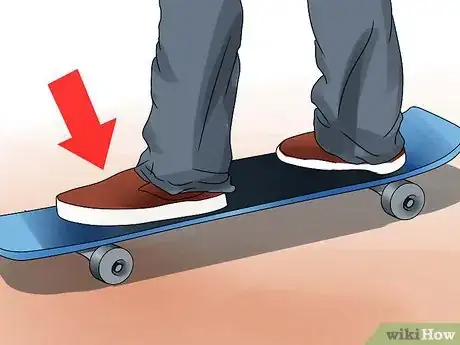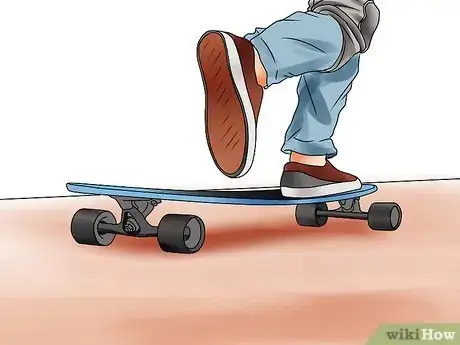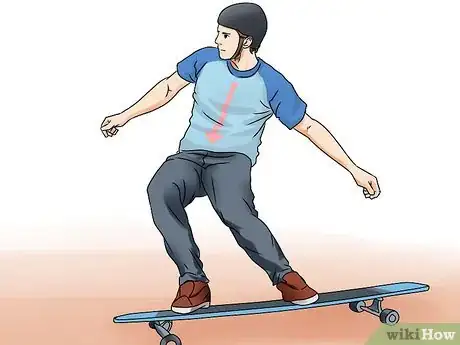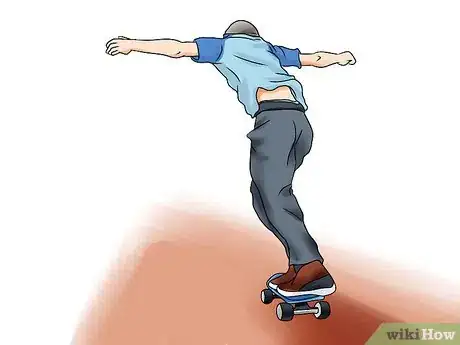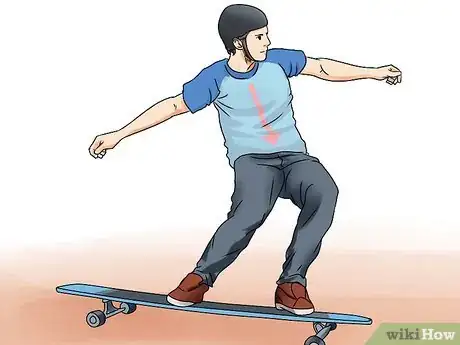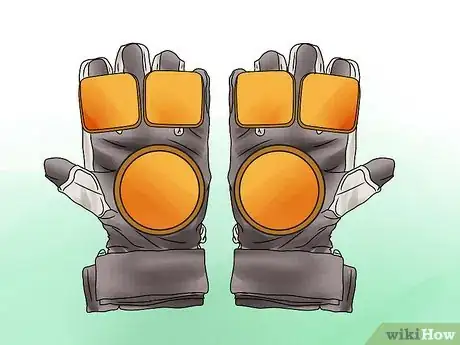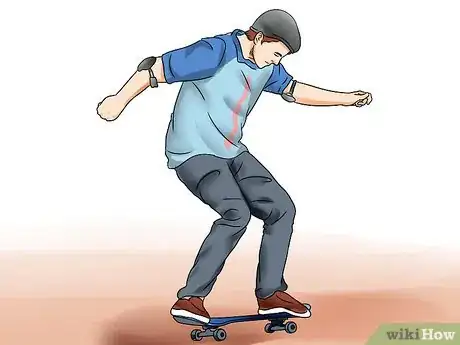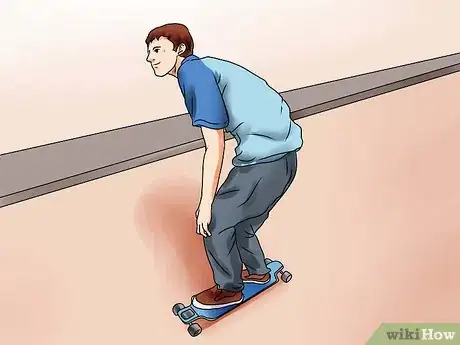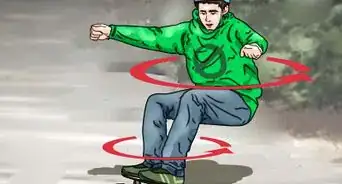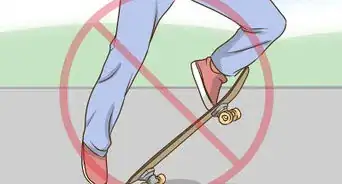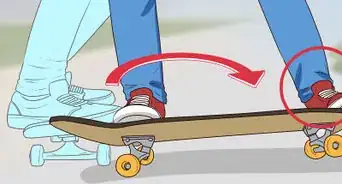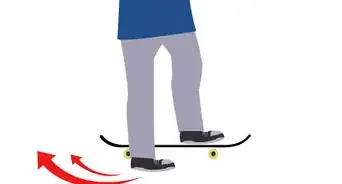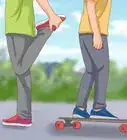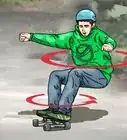This article was co-authored by Jon Depoian. Jon Depoian is a Skateboarding Instructor and the Owner of Intro2Skateboarding, an organization based in Orange County, California that provides professional private, home-school, after-school, birthday party, and summer camp skateboard lessons for beginners and experienced skateboarders alike. Jon has over 21 years of skateboarding experience and over 10 years of skateboard instruction experience. He also has extensive experience producing street skateboarding videos and skating competitions.
There are 9 references cited in this article, which can be found at the bottom of the page.
wikiHow marks an article as reader-approved once it receives enough positive feedback. This article received 12 testimonials and 81% of readers who voted found it helpful, earning it our reader-approved status.
This article has been viewed 815,205 times.
Longboarding is a sport similar to skateboarding. It uses a longer board, bigger wheels and sometimes bigger trucks to let the sport of longboarding include speed, freeride, slide and slalom. Longboarding is a lot of fun, and it's arguably easier to pick up as a beginner than skateboarding is. If you have a longboard and a little bit of time on your hands, get out there and start practicing! Before you do, read this handy tutorial.
Steps
Starting Off
-
1Decide what you are looking for in a board. Are you looking for a board to cruise on around town? To hit the skatepark with? Or are you looking to rip down big hills?
- Different sized longboards have different advantages and disadvantages. Shorter longboards are more agile (meaning you can turn more) but less stable (meaning it's easier to fall over). Longer boards are more stable but less agile. Beginners should stick with longer boards.[1]
-
2Get some protective gear. You may not think it's the coolest way to longboard, but especially when you're practicing, it's a good idea to be padded up. If you're doing more extreme versions of longboarding, getting padded up is essential.[2]
- For gear, be sure to get:
- A good-fitting helmet
- Skateboarding shoes (flat bottomed)
- Elbow pads (optional)
- Knee pads (optional)
- Slide Gloves (depend on the board you have)
Advertisement - For gear, be sure to get:
-
3Figure out if you are goofy or regular. Do you skate with your right foot forward? That's called riding "goofy." Do you skate with your left foot facing forward? That's called regular.[3]
- To find out whether you ride regular or goofy, have someone shove you from behind with no warning. Whichever foot you put out to catch yourself is the one you want to lead with on the skateboard. If it feels wrong, try switching to the other foot.
- Another way to find out is to slide on a smooth surface in socks or lay on the ground; whichever foot you use to get up with will be the foot you want to lead with on your longboard.
-
4Try riding it around a couple times on a flat surface. Try to feel the smooth flow as it rolls over the concrete. The lower you keep your center of gravity, the better you will feel. Make sure you feel comfortable before moving on.[4]
-
5Get the basic stance down. Stand with your feet between the trucks (the bearings that hold the wheels), a little longer than shoulder-width apart. Angle your front foot slightly forward, at about a 45 degree angle. Have your back foot be pretty much sideways, perpendicular to the direction the board is traveling in.[5]
- This is just one stance that you can use. After getting comfortable with your longboard for a little bit, you very well could find that other stances work better for you. Go with what feels comfortable.
-
6Practice balancing on your board by finding a gentle slope and going down it on the longboard. Get the hang of what it feels like to be on a longboard. Use your arms for balance and bend your knees a bit.[6]
-
7Balance yourself. If you feel out of control, make sure you focus far in front of you using your peripheral vision to guide you. This will allow your body to naturally gain control or balance.[7]
Longboarding Basics
-
1Practice moving yourself forward. Take your back foot off the board and use the ground as something to push off of. You can go for one big push, or several smaller pushes. Try to keep your body loose as you push off; the stiffer your body is, the harder it will be to keep your balance.[8]
- If you want to use your front foot to push off, give it a try. Most boarders don't do this — it's called "mongo" — but it's more important do ride comfortably than do what other people do.[9]
- After you get the hang of it, practice generating more speed by doing harder kicks. You'll find that, after you've gotten to a certain speed, one good push will keep you going for quite a while.
-
2Practice turning, or carving, on your longboard. You'll need to practice turning on your board if you want to ride around. Turning is quite easy. All you have to do is put pressure down on one side of the board, leaning in that direction, and you'll turn:[10]
- Heel edge carving: you move your heels downward and you turn to your inside. Heel edge turns for people who ride regular give you left turns.
- Toe edge carving: you move your toes downward and you turn to your outside. Toe edge turns for people who ride regular give you right turns.
-
3Find a way to stop your skateboard or to slow down. Foot-braking, where you drag one foot on the ground, is probably the most reliable way to stop or slow down: you're creating a lot of friction with your foot, thereby slowing the momentum of the board down.[11] Other ways that you can break include:
- Carving: snaking down the hill by leaning from side to side pushes on your wheels and will help keep speed down.
- Air braking: at high speeds, simply standing up and putting your arms out can slow you considerably.
-
4Practice sliding after you've mastered these concepts. If you ever want to go faster than you can run, save yourself some road rash by learning how to slide. In order to slide, you should either buy slide gloves, or attach squares of cutting board (find it in the supermarket) to work gloves. Once you have your gloves, you're ready to go learn to slide! In order to slide:[12]
- Point your front foot forward while bending your knees; shift your weight to the front.
- Slide your back foot off your board, flexing your front knee to make contact with the ground.
- Apply gradual pressure to stop
- Try not to use your toes or heel to touch the ground; instead, opt for the middle of your sole.
- It is also very important you don't put weight on your back foot. Doing that will almost ensure you will slip backwards. Try to keep more weight on the foot you have in front, leaning forwards is much safer than leaning back.
-
5Save yourself some road rash and learn to slide with gloves before you get going really fast. Start slow, and work your way up. Rome wasn't built in a day.
-
6Don't worry if your board doesn't look like the one in the videos. Everybody has different preferences. Getting comfortable with a board takes time and the techniques work for almost any shape and size board. Hard wheels (durometer of at least 86a) break traction easier, making learning to slide easier.
-
7Have fun but be careful. Longboarding is a ton of fun, but pushing it too hard can cause serious injury. You never think it'll be you until it actually happens to you. Be mindful of potentially dangerous situations and prepare accordingly or take yourself out of them before it's too late. That being said, have a blast cruising on your new toy![13]
Expert Q&A
Did you know you can get expert answers for this article?
Unlock expert answers by supporting wikiHow
-
QuestionWhat's the best place to practice longboarding?
 Jon DepoianJon Depoian is a Skateboarding Instructor and the Owner of Intro2Skateboarding, an organization based in Orange County, California that provides professional private, home-school, after-school, birthday party, and summer camp skateboard lessons for beginners and experienced skateboarders alike. Jon has over 21 years of skateboarding experience and over 10 years of skateboard instruction experience. He also has extensive experience producing street skateboarding videos and skating competitions.
Jon DepoianJon Depoian is a Skateboarding Instructor and the Owner of Intro2Skateboarding, an organization based in Orange County, California that provides professional private, home-school, after-school, birthday party, and summer camp skateboard lessons for beginners and experienced skateboarders alike. Jon has over 21 years of skateboarding experience and over 10 years of skateboard instruction experience. He also has extensive experience producing street skateboarding videos and skating competitions.
Skateboarding Instructor
-
QuestionIs it easier to ride a regular skateboard or a longboard?
 Jon DepoianJon Depoian is a Skateboarding Instructor and the Owner of Intro2Skateboarding, an organization based in Orange County, California that provides professional private, home-school, after-school, birthday party, and summer camp skateboard lessons for beginners and experienced skateboarders alike. Jon has over 21 years of skateboarding experience and over 10 years of skateboard instruction experience. He also has extensive experience producing street skateboarding videos and skating competitions.
Jon DepoianJon Depoian is a Skateboarding Instructor and the Owner of Intro2Skateboarding, an organization based in Orange County, California that provides professional private, home-school, after-school, birthday party, and summer camp skateboard lessons for beginners and experienced skateboarders alike. Jon has over 21 years of skateboarding experience and over 10 years of skateboard instruction experience. He also has extensive experience producing street skateboarding videos and skating competitions.
Skateboarding Instructor
-
QuestionShould I start out on a penny board?
 Jon DepoianJon Depoian is a Skateboarding Instructor and the Owner of Intro2Skateboarding, an organization based in Orange County, California that provides professional private, home-school, after-school, birthday party, and summer camp skateboard lessons for beginners and experienced skateboarders alike. Jon has over 21 years of skateboarding experience and over 10 years of skateboard instruction experience. He also has extensive experience producing street skateboarding videos and skating competitions.
Jon DepoianJon Depoian is a Skateboarding Instructor and the Owner of Intro2Skateboarding, an organization based in Orange County, California that provides professional private, home-school, after-school, birthday party, and summer camp skateboard lessons for beginners and experienced skateboarders alike. Jon has over 21 years of skateboarding experience and over 10 years of skateboard instruction experience. He also has extensive experience producing street skateboarding videos and skating competitions.
Skateboarding Instructor
Warnings
- Always take caution when longboarding in public areas.⧼thumbs_response⧽
- Would you jump out of a car at 30 mph (48 km/h)? It's easy to get to that speed on a longboard, make sure you learn how to stop!⧼thumbs_response⧽
- Always longboard in a place with no traffic.⧼thumbs_response⧽
- Longboarding is a dangerous sport. Do it at your own risk.⧼thumbs_response⧽
- Always wear a helmet, pads, and gloves.⧼thumbs_response⧽
Things You'll Need
- Longboard
- Pads
- Helmet
- Gloves
- A long section of smooth concrete
References
- ↑ Jon Depoian. Skateboarding Instructor. Expert Interview. 5 June 2020.
- ↑ Jon Depoian. Skateboarding Instructor. Expert Interview. 5 June 2020.
- ↑ https://www.youtube.com/watch?v=PYtJzBL6-YI
- ↑ Jon Depoian. Skateboarding Instructor. Expert Interview. 5 June 2020.
- ↑ https://www.ridingboards.com/longboard-stance/
- ↑ https://www.youtube.com/watch?v=z-JkCtbcMWY&feature=emb_logo
- ↑ https://www.youtube.com/watch?v=z-JkCtbcMWY&feature=emb_logo
- ↑ https://longboardbrand.com/important-longboard-tips-for-a-comfortable-ride/
- ↑ https://www.youtube.com/watch?v=PbfrXDCv4ZE
- ↑ Jon Depoian. Skateboarding Instructor. Expert Interview. 5 June 2020.
- ↑ https://longboardbrand.com/how-to-slow-down-on-a-longboard/
- ↑ https://www.youtube.com/watch?v=--34ICM9rU0
- ↑ https://www.ridingboards.com/longboarding-safety/
About This Article
To try skateboarding on a longboard, start by standing on the board with your feet slightly wider than shoulder-width apart. Next, push off with your back foot to move forward, then bend slightly at the knees and spread out your arms to help you balance. In order to stop or slow down, take either foot off the board and drag it on the ground. If you want to turn on your longboard, just lean down on the board in the direction you want to turn. To learn more, like how to choose the right longboard for your experience level, read on!



